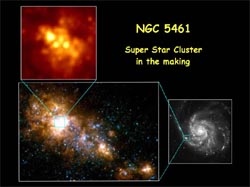This area deals with the fundamental laws and building blocks of nature and how they interact, the properties and the behavior of matter, and research into space and time and their structures.
innovations-report provides in-depth reports and articles on subjects such as astrophysics, laser technologies, nuclear, quantum, particle and solid-state physics, nanotechnologies, planetary research and findings (Mars, Venus) and developments related to the Hubble Telescope.

Hubble astronomers have uncovered, for the first time, a population of infant stars in the Milky Way satellite galaxy, the Small Magellanic Cloud (SMC, visible to the naked eye in the southern constellation Tucana), located 210,000 light-years away.
The exquisite sharpness of the NASA/ESA Hubble Space Telescope has plucked out an underlying population of infant stars embedded in the nebula NGC 346 that are still forming from gravitationally collapsing gas clouds. They have not

Astronomers using the Gemini South 8-meter telescope in Chile have observed new details in the dusty disk surrounding the nearby star Beta Pictoris which show that a large collision between planetary-sized bodies may have occurred there as recently as the past few decades.
The mid-infrared observations provide the best evidence yet for the occurrence of energetic encounters between planetesimals (small bodies formed of rock or ice) during the process of planetary formation. Amaz

Major Observing Programme Leads to New Theory of Galaxy Formation
Most present-day large galaxies are spirals, presenting a disc surrounding a central bulge. Famous examples are our own Milky Way or the Andromeda Galaxy. When and how did these spiral galaxies form? Why do a great majority of them present a massive central bulge?
An international team of astronomers [1] presents new convincing answers to these fundamental questions. For this, they rely on an extensive data

On Christmas Day 2004, the Cassini spacecraft flawlessly released ESA’s Huygens probe, passing another challenging milestone for Cassini-Huygens mission. But, with no telemetry data from Huygens, how do we know the separation went well?
At 3:00 CET on 25 December, the critical sequence loaded into the software on board Cassini was executed and, within a few seconds, Huygens was sent on its 20-day trip towards Titan. As data from Cassini confirm, the pyrotechnic devices were fir

Deal unites firms with shared vision of affordable access to space
Surrey Satellite Technology Ltd (SSTL), the British world-leader in advanced small satellites, has announced the sale of a ten percent stake to California-based commercial rocket company SpaceX. The transaction enables the two companies to work together closely to achieve their shared vision of making access to space significantly cheaper and more responsive.
Rapid response microsatellites and minisatellit

A trio of massive, young star clusters found embedded in a star cloud may shed light on the formation of super-star clusters and globular clusters.
The discovery, made with images taken with the Hubble Space Telescope, is being presented today by You-Hua Chu and Rosie Chen of the University of Illinois at Urbana-Champaign and Kelsey Johnson of the University of Virginia to the American Astronomical Society meeting in San Diego. This finding indicates that super-star clusters may b